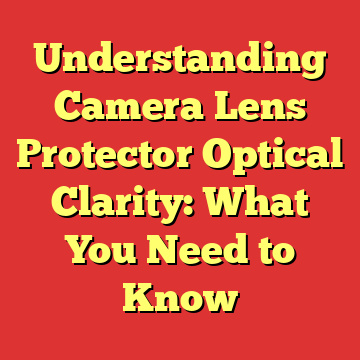Understanding Camera Lens Protector Optical Clarity: What You Need to Know
When it comes to photography, the lens is often considered the heart of your camera. It captures light, color, and detail, transforming the world around you into stunning images. But what happens when you add a layer of protection to that lens? Enter the camera lens protector. While these accessories can safeguard your equipment from scratches or damage, they also bring an essential question to the forefront: how does a lens protector affect optical clarity? Let’s delve into this topic and explore what you need to know.
The Purpose of a Lens Protector
Before we get into the nitty-gritty of optical clarity, it’s crucial to understand why photographers often use lens protectors. Imagine your lens as a delicate flower in a bustling garden, vulnerable to the elements. A lens protector acts as a shield, defending against dust, dirt, and accidental bumps. It’s a smart investment, especially for those who love outdoor photography or frequently travel with their gear.
What is Optical Clarity?
Optical clarity refers to how well light passes through a material without distortion or loss of detail. Think of it as the transparency of a window: the clearer the glass, the better your view. In photography, optical clarity is paramount; any obstruction could lead to blurry images or unwanted color shifts. So, when considering a lens protector, it’s essential to evaluate how it impacts this clarity.
Types of Lens Protectors
There are several types of lens protectors on the market, each with different optical properties. Here’s a brief overview:
1. **UV Filters**: Initially designed to block ultraviolet light, UV filters are often used as protective covers. However, their impact on clarity can vary based on quality.
2. **Clear Filters**: These are made specifically for protection without altering the image. A high-quality clear filter can provide excellent optical clarity.
3. **Polarizing Filters**: These filters reduce glare and enhance colors. While they serve a dual purpose, they can introduce complexity into your optical setup.
Understanding the type of lens protector you choose is crucial. A low-quality filter can introduce distortion, while a high-quality option can provide peace of mind without sacrificing image quality.
Factors Affecting Optical Clarity
Several factors can influence the optical clarity of a lens protector:
1. **Material Quality**: The materials used in manufacturing the lens protector can significantly affect clarity. High-quality optical glass offers better clarity compared to cheaper, lower-grade plastics.
2. **Coatings**: Many lens protectors come with anti-reflective coatings. These coatings help minimize glare and reflections, enhancing overall image quality. Think of it like putting on a pair of high-quality sunglasses; they can cut down on glare, allowing you to see more clearly.
3. **Thickness**: While a thicker protector may offer more durability, it can also introduce potential distortion. This is where the balance between protection and clarity becomes critical.
How to Assess Optical Clarity
So, how can you determine if a lens protector maintains optical clarity? Here are a few tips:
– **Test Shots**: Take photos with and without the protector under similar conditions. Compare the results to see if there’s any noticeable difference in sharpness or color.
– **Check for Distortion**: Look for any unintended effects, such as blurring or color shifts in the corners of your images. A good quality protector should be nearly invisible in terms of performance.
– **Read Reviews**: Research user reviews and expert opinions before making a purchase. Often, this can provide insight into real-world performance and help you avoid low-quality options.
Conclusion
Investing in a camera lens protector can be a wise decision for any photographer. However, understanding how it affects optical clarity is crucial. By considering the material, coatings, and thickness of the protector, you can make an informed choice that balances protection with image quality. Remember, just like a good pair of glasses enhances your vision, the right lens protector should enhance your photography experience without compromising clarity.
FAQs
1. Do lens protectors affect image quality?
Yes, lens protectors can affect image quality. High-quality protectors maintain optical clarity, while lower-quality options may introduce distortion.
2. Should I always use a lens protector?
While it’s not mandatory, using a lens protector is advisable if you frequently shoot in challenging conditions or want to safeguard your investment.
3. How can I clean my lens protector without scratching it?
Use a microfiber cloth and lens cleaning solution designed for optical glass. Avoid abrasive materials that could scratch the surface.
